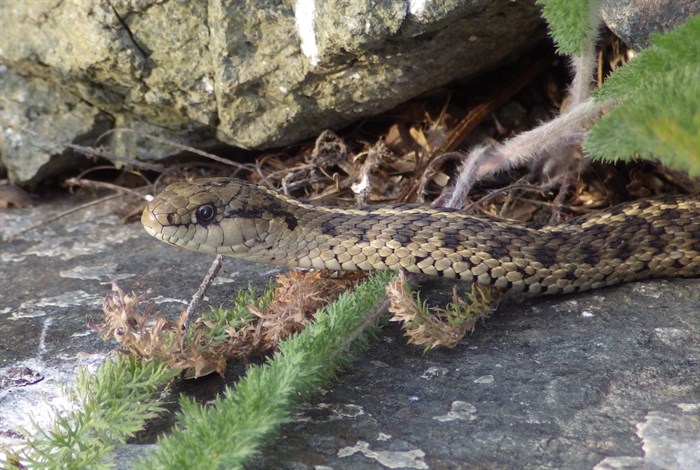
Western Terrestrial Garter Snake.
Image Credit: Karl Larsen
June 08, 2019 - 10:30 AM
Vilified over time by everybody from Hollywood to the Old Testament, snakes are generally given a bad rap by most, but depending on your point of view, the Thompson-Okanagan is lucky enough to have seven of the nine species of snake that call B.C. home.
While these snakes can strike fear into people, six out of the seven species that live here are totally harmless, and even the notorious rattlesnake is still pretty low down on the worldwide chart of dangerous snakes.
While scrolling through social media it may appear the Thompson-Okanagan is awash with snakes, actual numbers are down as habitat loss and roadkill makes a dent in their numbers.
Here at iNFOnews.ca we reached out to snake expert Karl Larsen, a professor in the department of natural resource science at Thompson Rivers University to give us the low down on snakes in the Interior.
So next time you see one, you can identify it (before screaming).
1) Common garter snake. Somewhat ironically, Larsen says these snakes aren't actually that common anymore. The garter snake likes to hunt near marshes and ponds where they eat frogs, leeches and sometimes small fish. A really big garter snake could grow to about one metre long and 2.5 centimetres wide. They're not venomous. Like all snakes, they can bite, although the chances of this happening are extremely rare. Larsen said very few snakes worldwide will be outwardly aggressive and most snakes just want to be avoided. When in a snake habitat people should be "wary and cautious, but not fearful." As the garter snake doesn't have size or venom on their side, the snakes secrete a musk in defence.
"A lot of people get quite sick when they smell it," Larsen said.

Common Garter Snake, ironically not that common.
Image Credit: Wikimedia Commons
2) Western terrestrial garter snake. Photo at the top. "Maybe the worse named animal we have in the province," Larsen said. They're often found along rivers and ponds and swimming. They eat fish and small mammals, like mice and shrews. Of all the snakes in the Interior, numbers of the western terrestrial garter snake seem to be doing okay, Larsen said. Like the common garter snake, they can grow to a maximum of roughly one metre long and secrete a musk as a defence.
3) Rubber Boa. The world's most northerly boa snake. "[They're] closely related to anacondas and boa constrictors... but a lot smaller," Larsen said. They grow to about 80 cm in length and 2.5 cm wide and are very secretive. "If you see one you're having a lucky day," Larsen said. Even after 35 years of studying and searching for snakes, Larsen said he's probably seen about half a dozen in the wild.
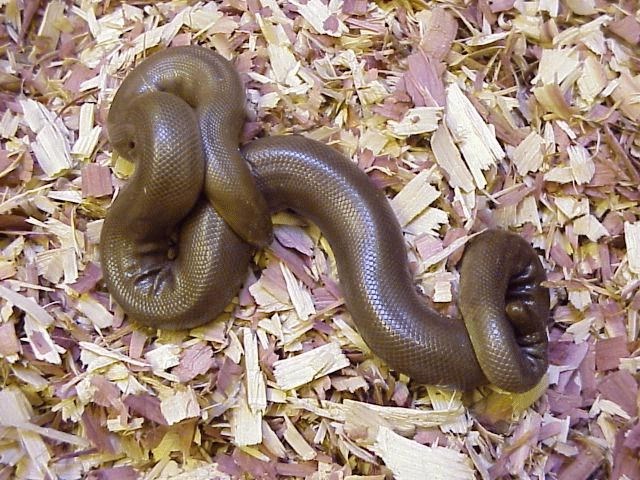
Rubber boa.
Image Credit: Karl Larsen
4) Western rattlesnake. The only venomous snake we have, but it would be rare for a rattlesnake to bite. They grow to about one metre long and up to five centimetres in width. The snakes puff themselves up in fear so may appear bigger than they actually are. The rattle is a warning device and striking or biting is the last resort of a rattlesnake, Larsen said.
"They'll try to remain secretive and not be detected." Larsen has been bitten a few times himself and describes it as "just like a mosquito... you don't feel a thing." Sometimes people get bit and they don't even realize, he said. But if you do get bitten it's very important to go straight to the hospital as it is potentially very dangerous. Larsen also said what you may have seen in movies doesn't work, so don't try sucking, cutting or ice, "just go to the hospital." The snakes eat small mammals, birds, rats, mice, red squirrels and even baby marmots. Larsen said they are not "super common" in the Interior but research into snake populations hasn't been conducted for 35 years and is just starting up again now.
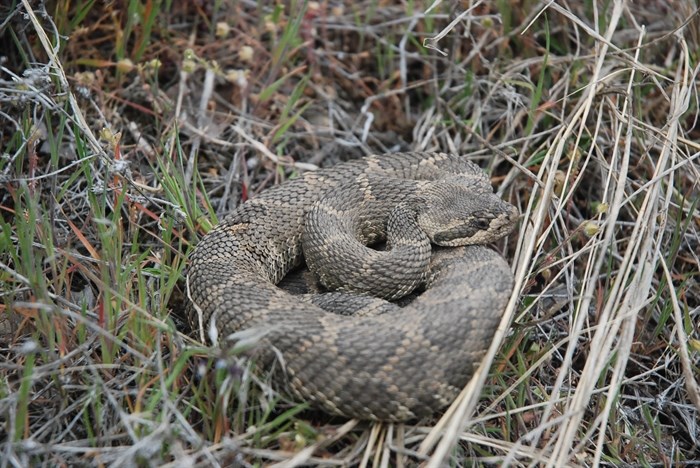
Western rattlesnake.
Image Credit: Karl Larsen
5) Great basin gopher snake. (Often called a bull snake). The largest snake in the region. Historically they grow up to two metres in length, although Larsen says you don't see the big ones anymore because they just don't live long enough. While most snakes don't actually make a hissing sound, the gopher snake does hiss and likes to imitate rattlesnakes. Part of the constrictor family, the gopher snake can wrap itself around a squirrel and kill it very quickly, Larsen said.
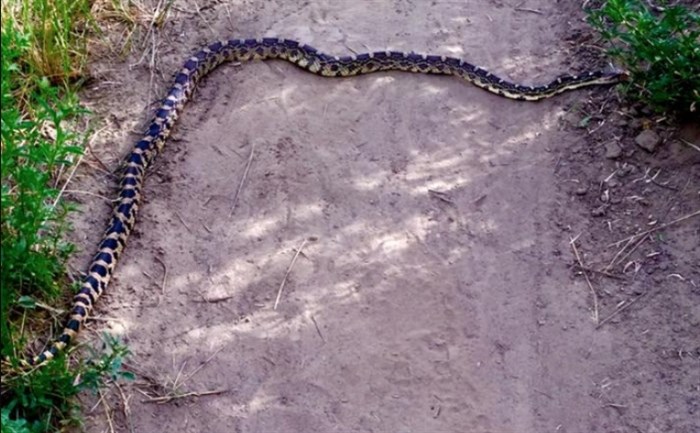
Great basin gopher snake.
Image Credit: Karl Larsen
6) Western yellow-bellied racer snake. The only snake living in the Interior that will eat insects and "just about anything else it can swallow," including other snakes. True to their name, the racer snake is very fast-moving and does have a yellow belly. They can grow to about one metre in length and 2.5 cm wide.
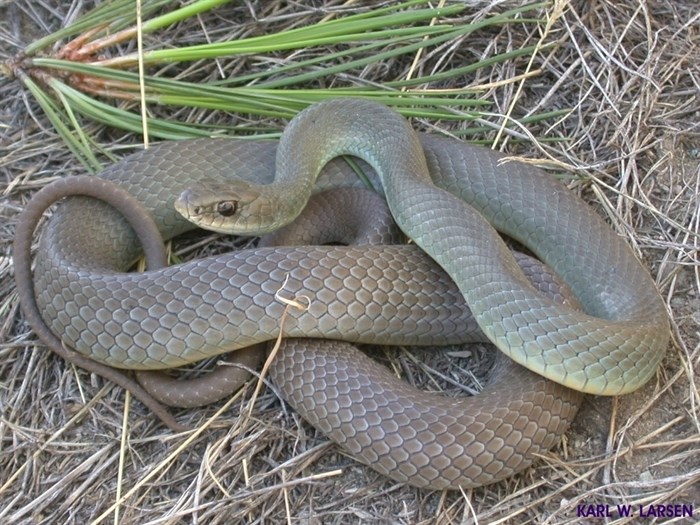
Western yellow bellied racer snake
Image Credit: Karl Larsen
7) Night snake. Larsen said they live just inside the Canadian border and are incredibly rare with about 80 sightings of the snake recorded. They grow to about 60 cm in length, only get as wide as about 1.5 cm. As the name would suggest, the night snake is nocturnal. Even after almost four decades studying snakes, Larsen has never seen one in the wild.
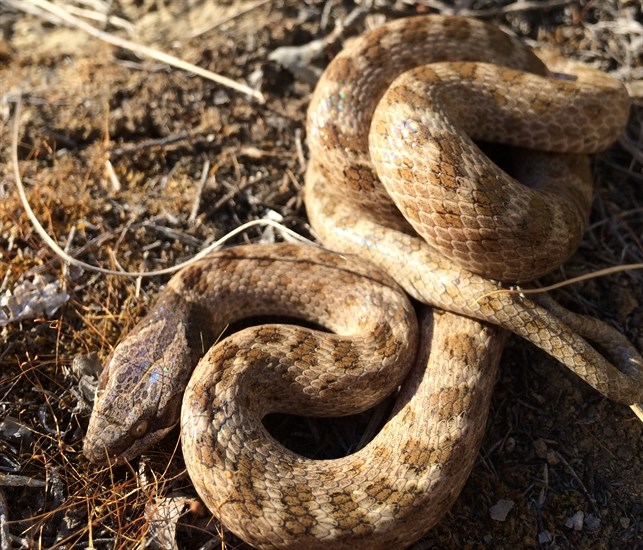
Night snake.
Image Credit: Karl Larsen
— This story was edited at 11:52 a.m. June 5 in response to reader comments asking about bull snakes. Bull snake is a commonly used name for the gopher snake in this story.
To contact a reporter for this story, email Ben Bulmer or call (250) 309-5230 or email the editor. You can also submit photos, videos or news tips to the newsroom and be entered to win a monthly prize draw.
We welcome your comments and opinions on our stories but play nice. We won't censor or delete comments unless they contain off-topic statements or links, unnecessary vulgarity, false facts, spam or obviously fake profiles. If you have any concerns about what you see in comments, email the editor in the link above.
News from © iNFOnews, 2019